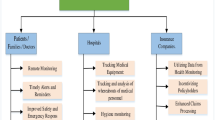Abstract—
Ring signature augmented by revocation with controlled linkability is proposed. The possibility of using this approach in the Smart Grid as an example of Industrial Internet of Things systems is discussed.






Similar content being viewed by others
REFERENCES
Dakhnovich, A.D., Moskvin, D.A., and Zegzhda, D.P., Analysis of the information security threats in the digital production networks, Autom. Control Comput. Sci., 2018, vol. 52, no. 8, pp. 1071–1075.
Pavlenko, E., Zegzhda, D., and Styrkina, A., Estimating the sustainability of cyber-physical systems based on spectral graph theory, 2019 IEEE International Black Sea Conference on Communications and Networking, 2019. https://doi.org/10.1109/BlackSeaCom.2019.8812826
Pavlenko, E. and Zegzhda, D., Sustainability of cyber-physical systems in the context of targeted destructive influences, IEEE Industrial Cyber-Physical Systems, 2018, pp. 830–834.
Kalinin, M.O. and Minin, A.A., Security evaluation of a wireless ad-hoc network with dynamic topology, Autom. Control Comput. Sci., 2017, vol. 51, no. 8, pp. 899–901.
Ovasapyan, T.D., Moskvin, D.A., and Kalinin, M.O., Using neural networks to detect internal intruders in vanets, Autom. Control Comput. Sci., 2018, vol. 52, no. 8, pp. 954–958.
Demidov, R.A., Zegzhda, P.D., and Kalinin, M.O., Threat analysis of cyber security in wireless adhoc networks using hybrid neural network model, Autom. Control Comput. Sci., 2018, vol. 52, no. 8, pp. 971–976.
Kalinin, M., Krundyshev, V., and Zubkov, E., Estimation of applicability of modern neural network methods for preventing cyberthreats to self-organizing network infrastructures of digital economy platforms, SHS Web Conf., 2018, vol. 44. https://doi.org/10.1051/shsconf/20184400044
Krundyshev, V. and Kalinin, M., Hybrid neural network frame work for detection of cyber attacks at smart infrastructures, Proceedings of the 3rd World Conference on Smart Trends in Systems, Security and Sustainability, 2019, pp. 129–135.
Kalinin, M.O., Zubkov, E.A., Suprun, A.F., and Pechenkin, A.I., Prevention of attacks on dynamic routing in self-organizing adhoc networks using swarm intelligence, Autom. Control Comput. Sci., 2018, vol. 52, no. 8, pp. 977–983.
Lavrova, D., Zegzhda, D., and Yarmak, A., Using GRU neural network for cyber-attack detection in automated process control systems, IEEE International Black Sea Conference on Communications and Networking (BlackSeaCom), Sochi, 2019, pp. 1–3.
Zegzhda, P.D., Malyshev, E.V., and Pavlenko, E.Y., The use of an artificial neural network to detect automatically managed accounts in social networks, Autom. Control Comput. Sci., 2017, vol. 51, no. 8, pp. 874–880.
Belenko, V., Krundyshev, V., and Kalinin, M., Intrusion detection for Internet of Things applying metagenome fast analysis, Proceedings of the 3rd World Conference on Smart Trends in Systems, Security and Sustainability, 2019, pp. 129–135.
El-hajj, M., et al., A survey of Internet of Things (IoT) authentication schemes, Sensors, 2019, vol. 19, no. 5, p. 1141.
Busygin, A.G., Konoplev, A.S., and Kalinin, M.O., Approaches to protection of applications based on the TLS protocol against attacks using revoked certificates, Autom. Control Comput. Sci., 2016, vol. 50, no. 8, pp. 743–748.
Busygin, A., Konoplev, A., Kalinin, M., and Zegzhda, D., Floating genesis block enhancement for blockchain based routing between connected vehicles and software-defined VANET security services, ACM International Conference Proceeding Series, 2018. https://doi.org/10.1145/3264437.3264463
Busygin, A.G., Konoplev, A.S., and Kalinin, M.O., Approaches to protection of applications based on the TLS protocol against attacks using revoked certificates, Autom. Control Comput. Sci., 2016, vol. 50, no. 8, pp. 743–748.
Aleksandrova, E.B., Yarmak, A.V., and Kalinin, M.O., Analysis of approaches to group authentication in large-scale industrial systems, Autom. Control Comput. Sci., 2019, vol. 53, no. 8, pp. 879–882.
Lavrova, D.S., Forecasting the state of components of smart grids for early detection of cyberattacks, Autom. Control Comput. Sci., 2019, vol. 53, no. 8, pp. 1023–1025.
Krundyshev, V. and Kalinin, M. Prevention of false data injections in smart infrastructures, 2019 IEEE International Black Sea Conference on Communications and Networking, BlackSeaCom 2019, 2019. https://doi.org/10.1109/BlackSeaCom.2019.8812786
Chalapathi, G.S.S., et al., Industrial Internet of Things (IIoT) Applications of Edge and Fog Computing: A Review and Future Directions, 2019. arXiv:1912.00595.
Kalinin, M., Krundyshev, V. Zegzhda, P., and Belenko, V., Network security architectures for VANET, ACM International Conference Proceeding Series, 2017, pp. 73–79. https://doi.org/10.1145/3136825.3136890
Kalinin, M., Krundyshev, V. Rezedinova, E., and Zegzhda, P., Role-based access control for vehicular adhoc networks, 2018 IEEE International Black Sea Conference on Communications and Networking, 2018. https://doi.org/10.1109/BlackSeaCom.2018.8433628
Zegzhda, P.D., Ivanov, D.V., Moskvin, D.A., and Kubrin, G.S., Actual security threats for vehicular and mobile ad hoc networks, Autom. Control Comput. Sci., 2018, vol. 52, no. 8, pp. 993–999.
Aleksandrova, E.B. and Rekhviashvili, I.Sh., Organization of recall for the ring signature scheme, Probl. Inf. Bezop., Komp’yut. Sist., 2019, no. 2, pp. 80–85.
Post-Quantum Cryptography. Round 2 Submissions, 2017. https://csrc.nist.gov/Projects/Post-Quantum-Cryptography.
Wang, S., Zhao, R., and Zhang, Y., Lattice-based ring signature scheme under the random oracle model, Int. J. High Perform. Comput. Networking, 2018, vol. 11, no. 4, pp. 332–341.
Slamanig, D., Spreitzer, R., and Unterluggauer, T., Linking-based revocation for group signatures: A pragmatic approach for efficient revocation checks, International Conference on Cryptology in Malaysia, 2016, pp. 364–388.
Tang, Q., Public key encryption supporting plaintext equality test and user-specified authorization, Secur. Commun. Networks, 2012, vol. 5, no. 12, pp. 1351–1362.
Shamir, A., How to share a secret, Commun. ACM, 1979, vol. 22, no. 11, pp. 612–613.
Author information
Authors and Affiliations
Corresponding authors
Ethics declarations
The authors declare that they have no conflicts of interest.
Additional information
Translated by I. Obrezanova
About this article
Cite this article
Aleksandrova, E.B., Rekhviashvili, I.S. & Yarmak, A.V. Lattice-Based Ring Signature with Linking-Based Revocation for Industrial Internet of Things. Aut. Control Comp. Sci. 54, 888–895 (2020). https://doi.org/10.3103/S0146411620080039
Received:
Revised:
Accepted:
Published:
Issue Date:
DOI: https://doi.org/10.3103/S0146411620080039




